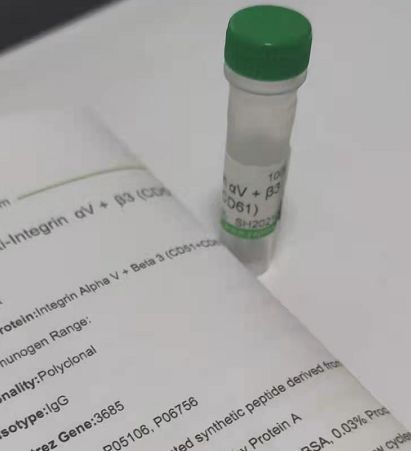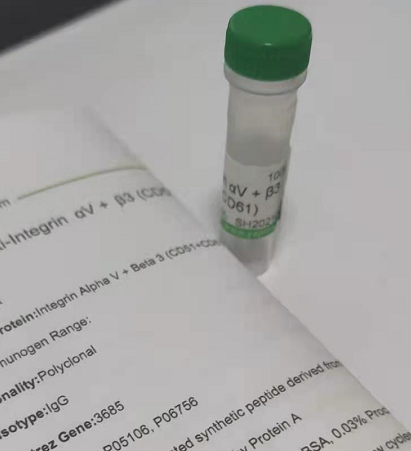| 產(chǎn)品編號 | Ys-3517R |
| 英文名稱 | PAK4 |
| 中文名稱 | p21激活激酶4抗體 |
| 別 名 | p21 activated kinase 4; p21(CDKN1A) activated kinase 4; PAK 4; Protein kinase related to S.cerevisiae STE20 effector for Cdc42Hs; Serine threonine kinase PAK 4; Serine/threonine protein kinase PAK 4; Serine/threonine protein kinase PAK4; KIAA1142; PAK4_HUMAN. |
| 抗體來源 | Rabbit |
| 克隆類型 | Polyclonal |
| 交叉反應(yīng) | (predicted: Human, Mouse, Rat, Chicken, Dog, Cow, Rabbit, ) |
| 產(chǎn)品應(yīng)用 | ELISA=1:5000-10000 not yet tested in other applications. optimal dilutions/concentrations should be determined by the end user. |
| 理論分子量 | 64kDa |
| 細胞定位 | 細胞漿 |
| 性 狀 | Liquid |
| 濃 度 | 1mg/ml |
| 免 疫 原 | KLH conjugated synthetic peptide derived from human PAK4: 501-591/591 |
| 亞 型 | IgG |
| 純化方法 | affinity purified by Protein A |
| 緩 沖 液 | 0.01M TBS(pH7.4) with 1% BSA, 0.03% Proclin300 and 50% Glycerol. |
| 保存條件 | Shipped at 4℃. Store at -20 °C for one year. Avoid repeated freeze/thaw cycles. |
| 注意事項 | This product as supplied is intended for research use only, not for use in human, therapeutic or diagnostic applications. |
| PubMed | PubMed |
| 產(chǎn)品介紹 | p21-activated kinases (PAKs) belong to the family of serine/threonine kinases involved in the control of various cellular processes, including the cell cycle, dynamics of the cytoskeleton, apoptosis, oncogenic transformation, and transcription. All PAK family members are characterized by the presence of p21-binding domain. p21-activated kinases are regulated by the small GTP-binding proteins Rac and Cdc42, and lipids, which stimulate autophosphorylation and phosphorylation of exogenous substrates. Serine (Ser-474) is the likely autophosphorylation site in the kinase domain of PAK4 in vivo. Phosphospecific antibodies directed against serine 474 detect activated PAK4 on the Golgi membrane when PAK4 is co-expressed with activated Cdc42. Current data strongly implicates PAK-4 in oncogenesis. PAK4 is frequently overexpressed in human tumor cell lines of various tissue origins. Function: Serine/threonine protein kinase that plays a role in a variety of different signaling pathways including cytoskeleton regulation, cell migration, growth, proliferation or cell survival. Activation by various effectors including growth factor receptors or active CDC42 and RAC1 results in a conformational change and a subsequent autophosphorylation on several serine and/or threonine residues. Phosphorylates and inactivates the protein phosphatase SSH1, leading to increased inhibitory phosphorylation of the actin binding/depolymerizing factor cofilin. Decreased cofilin activity may lead to stabilization of actin filaments. Phosphorylates LIMK1, a kinase that also inhibits the activity of cofilin. Phosphorylates integrin beta5/ITGB5 and thus regulates cell motility. Phosphorylates ARHGEF2 and activates the downstream target RHOA that plays a role in the regulation of assembly of focal adhesions and actin stress fibers. Stimulates cell survival by phosphorylating the BCL2 antagonist of cell death BAD. Alternatively, inhibits apoptosis by preventing caspase-8 binding to death domain receptors in a kinase independent manner. Plays a role in cell-cycle progression by controlling levels of the cell-cycle regulatory protein CDKN1A and by phosphorylating RAN. Subunit: Interacts with FGFR2 and GRB2. Interacts tightly with GTP-bound but not GDP-bound CDC42/p21 and weakly with RAC1. Subcellular Location: Cytoplasm. Note=Seems to shuttle between cytoplasmic compartments depending on the activating effector. For example, can be found on the cell periphery after activation of growth-factor or integrin-mediated signaling pathways. Tissue Specificity: Highest expression in prostate, testis and colon. Post-translational modifications: Autophosphorylated on serine residues when activated by CDC42/p21. Phosphorylated on tyrosine residues upon stimulation of FGFR2. Similarity: Belongs to the protein kinase superfamily. STE Ser/Thr protein kinase family. STE20 subfamily. Contains 1 CRIB domain. Contains 1 protein kinase domain. SWISS: O96013 Gene ID: |
我要詢價
*聯(lián)系方式:
(可以是QQ、MSN、電子郵箱、電話等,您的聯(lián)系方式不會被公開)
*內(nèi)容:









